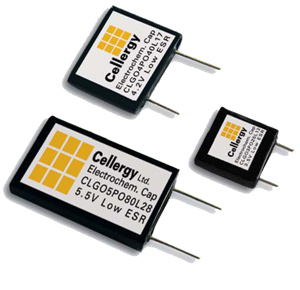Why should you use Ultra low ESR Super Capacitors in GSM/GPRS applications?
GSM Protocol Requires 2A Pulse for 0.6msec Every 4.2msec
GSM / GPRS modules are implemented mostly in M2M applications. These GSM/GPRS modules use either Lithium Ion rechargeable battery’s or Lithium Thionyl Chloride Battery non-rechargeable - primary. For both type of batteries it is recommend to use CLG04P050L28 or CLG03P120L28 both stocked by Farnell.
Case of Lithium Ion battery:
It is recommended to use a non Aqueous Ultra Low ESR Super Capacitor with lower or equal ESR to the internal resistance of the Lithium Ion Battery (~ 150 mΩ).
During the short GSM pick pulse of 2A, the Lithium Ion will deliver a maximum of 1A only.
This reduction will prevent serious "Voltage Recovery" effect (after high current pulse, battery voltage does not achieve it's previous value).
Adding these Super Capacitors will aid preventing the battery to enter "Voltage Recovery". Without a Super Cap the battery alone needs to provide 2A. This high current causes early discharge of the battery and prevents it getting closer to its shutdown threshold.
Between the GSM pulses during 4.2msec the battery can smoothly charge the Super Cap.
Conclusion – A low ESR Super Capacitor can contribute to lengthen the time between battery shutdowns. Adding Super Capacitors to GSM design is essential for smooth and longer operation.
Case of Lithium Thionyl Chloride Battery:
In cases where the primary battery alone is un able to provide GSM / GPRS 2A pulse. The Super Capacitor with its high capacitance and low ESR enables the required high current 2A short burst. As in the case LiON example between the 0.6msec GSM pulses, during 4.2msec the battery can smoothly charge the Super Capacitor.
Conclusion – A Super Capacitor is mandatory for operation and prevent battery shutdowns.
To view the range of stocked Cellergy supercaps please click here.


-

Former Member
-
Cancel
-
Vote Up
0
Vote Down
-
-
Sign in to reply
-
More
-
Cancel
Comment-

Former Member
-
Cancel
-
Vote Up
0
Vote Down
-
-
Sign in to reply
-
More
-
Cancel
Children